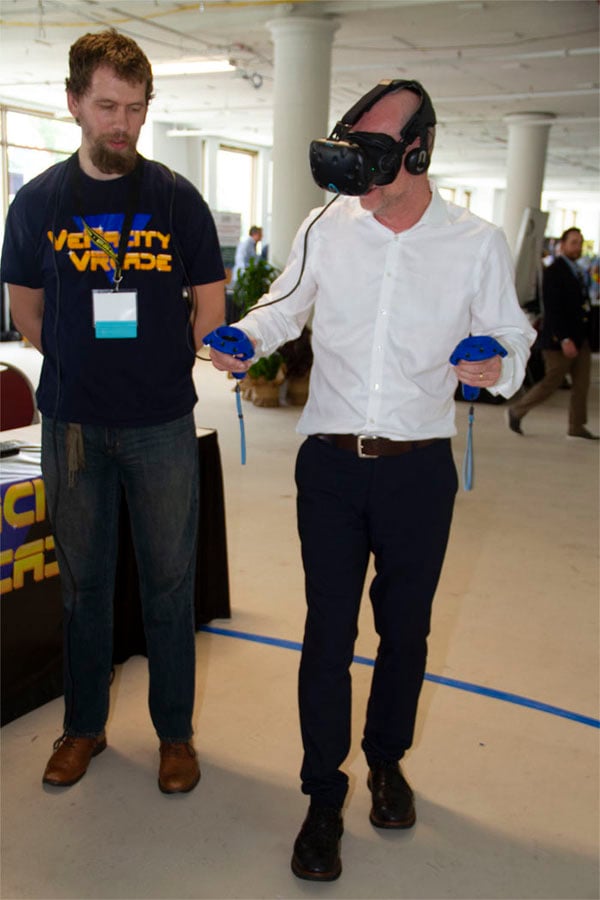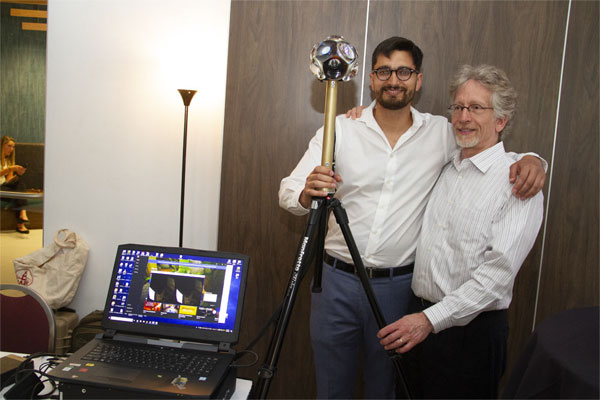ROCHESTER, N.Y., July 1, 2019 — At Light and Sound Interactive (LSI), held June 25-27 in Rochester, N.Y., the Augmented and Virtual Reality (AR/VR) track made one thing clear: The technology may, at some point, become as ubiquitous as smartphones.
A highlight of the track was the keynote address by Barry Silverstein of Facebook Reality Labs, in which he laid out an ambitious plan to make smartphones obsolete, as part of a “Mars shot” effort by the company to fast-track the development of optical and software capabilities that aren’t yet possible. One of these efforts is the company’s plan to create smart glasses that look like ordinary, or in Silverstein’s words, “socially acceptable” glasses.

Veracity VRcade demonstrates a game where the player must walk across a tightrope between two skyscrapers. Courtesy of Manon Mirabelli.
The smart glasses that Facebook envisions would be transparent to any onlooker. They would be capable of overlaying a heads-up display, but visible only to the wearer. Although this design is not currently possible, anyone who attended the AR/VR track likely left the keynote session believing that the technology isn’t completely out of reach.
One of the technologies Silverstein mentioned in his talk — an optical lens capable of both displaying AR and telephoto zoom — is theoretically possible and was the subject of a talk by Nick Vamivakas, associate professor of quantum optics and quantum physics at the University of Rochester’s Institute of Optics. By using metasurfaces, it’s theoretically possible to create a lens display capable of appearing transparent, as well as being able to zoom in on faraway objects, Vamivakas said.
In another talk, Michele Rucci addressed foveated rendering, in which only the area of focus appears in high resolution (to cut down on processing power and conserve battery life). Rucci is a professor of brain and cognitive sciences at Rochester. His presentation laid out some of the challenges of this technique of rendering, while showing that it is getting closer to where it needs to be to achieve the goals of tomorrow.
At LSI, there was no shortage of AR/VR technologies that are both currently possible and that present interesting implications for future industries, such as virtual tourism.

Zak Niazi (left), CEO of Circle Optics, and Allen Krisiloff, systems engineer. Courtesy of Manon Mirabelli.
Circle Optics, one of the startups in contention for the prestigious $1 million prize at the Luminate Awards, showcased a 360º camera that solves the extremely expensive problem of stitching.
Typical 360º cameras stitch an image together, which often results in an imperfect image with edges that do not line up. And in the past, costly software and training were required to finish the job. Circle Optics’ design is built to create a single image without stitching, using 11 f/2.0 lenses that boast a 39.7 MP resolution. This resolution is compressed to 8.4 MP for VR applications and is able to film at 30 fps. Circle Optics took 4th prize at the Luminate Awards and won the audience choice award.
The LSI conference is expected to return again next year in June. For more information, visit www.lightandsoundinteractive.com.